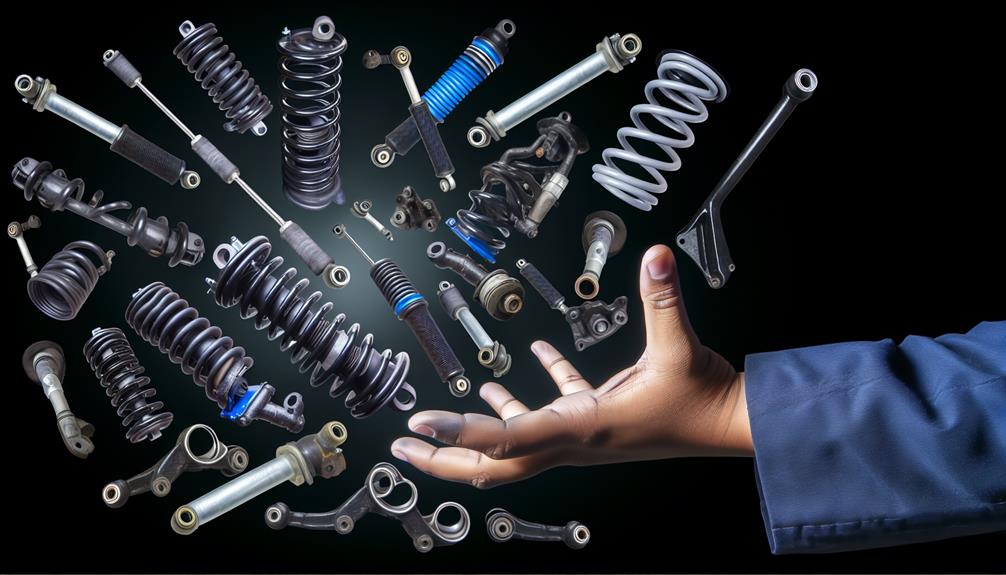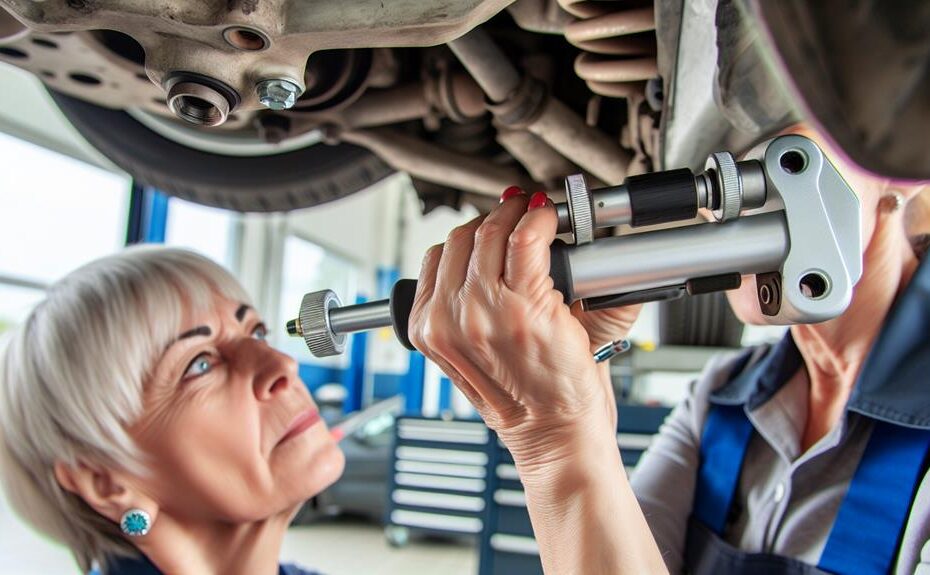Imagine your car's suspension as the backbone of its performance, providing stability and support on the open road.
Just like any backbone, it needs proper care and attention to ensure its optimal functionality.
So, you may be wondering, what are the top suspension repair tips that can keep your vehicle running smoothly?
Well, buckle up because we're about to unveil some invaluable insights that will help you navigate the twists and turns of suspension maintenance, ensuring a comfortable and safe ride.
Key Takeaways
- Uneven tire wear and excessive bouncing or swaying while driving are signs of suspension problems that should be inspected.
- Regular maintenance and inspections of suspension components are important to identify wear and tear and prevent issues.
- Properly adjusting suspension settings, such as sag and damping, can improve handling and comfort.
- Upgrading the suspension can enhance control, responsiveness, and safety, depending on specific riding needs and preferences.
Inspecting Suspension Components
Have you ever wondered how to properly inspect the suspension components of your vehicle? Well, if you want to ensure your safety and the performance of your vehicle, it's crucial to inspect your suspension regularly. By doing so, you can identify and address common suspension problems before they become major issues.
One of the signs of suspension wear is uneven tire wear. If you notice that your tires are wearing out unevenly, it could be due to a suspension problem. Another common sign is excessive bouncing or swaying while driving. If you feel like your vehicle isn't stable on the road or if it leans excessively during turns, it may be time to inspect your suspension components.
To properly inspect your suspension, start by visually inspecting the components for any signs of damage or wear. Look for leaks in the shock absorbers or struts, and check for any loose or broken parts. Additionally, perform a bounce test by pushing down on each corner of the vehicle and observing how it responds. If the vehicle bounces or sways excessively, it's a clear indication of suspension wear.
Identifying Common Suspension Issues
To effectively identify common suspension issues, start by visually inspecting the suspension components for any visible signs of damage or wear. This will help you determine if there are any problems that need to be addressed.
Here are some signs of suspension damage that you should look out for:
- Uneven tire wear: If you notice that the tread on your tires is wearing down unevenly, it could be a sign of suspension issues. This could indicate that the suspension isn't properly supporting the weight of the vehicle, causing the tires to wear out unevenly.
- Excessive bouncing: If your vehicle bounces excessively after going over bumps or dips in the road, it could be a sign that the suspension is worn out or damaged. This can affect the stability and control of your vehicle, making it unsafe to drive.
- Steering problems: Issues with the suspension can also affect the steering of your vehicle. If you notice that your vehicle pulls to one side or the steering feels loose or imprecise, it could be due to suspension problems.
Performing Regular Suspension Maintenance

Regular suspension maintenance is essential for ensuring optimal performance and safety of your vehicle. By properly maintaining your suspension system, you can prolong its lifespan and prevent costly repairs. It is important to regularly inspect your suspension components for signs of wear and tear. This allows you to identify potential issues early on and address them before they escalate into major problems. Here are some key signs of suspension wear and tear that you should look out for:
| Signs of Suspension Wear and Tear | |
|---|---|
| Uneven tire wear | Excessive bouncing or swaying |
| Vehicle pulling to one side | Noise or squeaking when going over bumps |
| Difficulty steering or controlling the vehicle | Leaking fluid or visible damage to suspension components |
If you notice any of these signs, it is important to have your suspension system inspected by a qualified mechanic. They can diagnose the problem and recommend the necessary repairs or replacements. Additionally, performing regular maintenance tasks such as lubricating joints, checking for loose bolts, and replacing worn-out components can help keep your suspension system in top condition. Remember, a well-maintained suspension system not only ensures a smooth and comfortable ride but also contributes to the overall safety and performance of your vehicle.
Properly Adjusting Suspension Settings
To properly adjust the settings of your suspension system, it's essential to understand the various components and their functions. Once you have a good grasp of these basics, you can begin making adjustments to optimize your suspension's performance.
Here are three key areas to focus on when adjusting your suspension settings:
- Adjusting Suspension Sag: Suspension sag refers to the amount the suspension compresses under the weight of the rider. It's crucial to set the sag correctly for optimal handling and comfort. Start by measuring the sag with the bike in its normal riding position. If the sag is too much or too little, adjust the preload on the suspension to achieve the desired sag.
- Troubleshooting Suspension Noises: Suspension noises can be annoying and indicate underlying issues. When troubleshooting suspension noises, start by checking for loose bolts or worn-out bushings. Inspect the suspension components for any signs of damage or excessive wear. If necessary, replace or repair the affected parts to eliminate the noise.
- Fine-tuning Compression and Rebound Damping: Compression and rebound damping control how the suspension compresses and rebounds. Fine-tuning these settings can greatly enhance your bike's handling and stability. Experiment with different damping settings to find the right balance between comfort and performance.
Choosing the Right Suspension Upgrades

When considering suspension upgrades, it's crucial to analyze your specific riding needs and preferences in order to select the most suitable options. Upgrading suspension systems can significantly enhance your riding experience by improving handling, stability, and overall performance.
There are several benefits of suspension modifications that you should consider.
Firstly, upgrading your suspension can provide better control and responsiveness. By installing high-quality shocks or struts, you can reduce body roll and improve the vehicle's ability to handle corners and uneven terrain. This is especially important for off-road enthusiasts or those who frequently drive on rough roads.
Secondly, suspension upgrades can enhance comfort and reduce vibrations. By replacing worn-out components with newer ones, you can enjoy a smoother and more comfortable ride. This is particularly beneficial for long drives or when carrying heavy loads.
Additionally, suspension modifications can increase the vehicle's towing and hauling capabilities. By installing heavy-duty springs or air suspension systems, you can improve the vehicle's stability and prevent sagging when carrying heavy loads or towing trailers.
Lastly, upgrading your suspension can also improve safety. A well-tuned suspension system can provide better traction and reduce the risk of skidding or losing control, especially in adverse weather conditions.
Frequently Asked Questions
Can I Inspect My Suspension Components Myself, or Should I Take My Vehicle to a Professional?
You can inspect your suspension components yourself, but taking your vehicle to a professional has benefits. They have the expertise and specialized tools to accurately diagnose and repair any issues, ensuring your suspension is in top condition.
How Often Should I Perform Regular Suspension Maintenance?
Performing regular suspension maintenance is crucial for optimal vehicle performance. You should inspect your suspension components frequently to ensure their proper functioning. Neglecting maintenance can lead to costly repairs and compromises your safety on the road.
What Are the Signs of Suspension Issues That I Should Be Aware Of?
You should be aware of the signs of suspension issues. Common suspension problems include uneven tire wear, excessive bouncing, and a rough ride. To diagnose suspension issues, check for leaks, inspect the shocks and struts, and listen for unusual noises.
Are There Any Specific Tools or Equipment Required to Adjust Suspension Settings?
To adjust suspension settings, you'll need specific tools like a torque wrench and adjustable spanner. Proper adjustment methods are crucial for optimal performance and safety. Make sure to check your vehicle's manual for recommended settings.
What Factors Should I Consider When Choosing the Right Suspension Upgrades for My Vehicle?
When choosing suspension upgrades for your vehicle, factors to consider include your driving style, desired ride quality, and budget. It's important to research and consult with experts to ensure you make the right choice.
Conclusion
In conclusion, maintaining a properly functioning suspension is crucial for optimal vehicle performance and safety. By regularly inspecting suspension components, identifying common issues, and performing necessary maintenance, you can ensure a smooth and comfortable ride.
Adjusting suspension settings correctly and choosing the right upgrades can further enhance your driving experience. Remember, a well-maintained suspension is the foundation that keeps your vehicle on the road, like sturdy pillars supporting a bridge.
